Beaches are vital ecosystems and cherished recreational spots. Keeping them clean is essential for preserving their natural beauty, protecting wildlife, and ensuring they remain safe and enjoyable for everyone. This guide outlines actionable steps visitors can take to minimize their impact and contribute to cleaner beaches.
1. Bring a Reusable Cleanup Kit
- Pack reusable items such as a cloth bag, gloves, and a small trash bag.
- Use these tools to collect your own waste and any litter you find.
- Encourage friends and family to join the effort during your visit.
2. Reduce Single-Use Plastics
- Bring a reusable water bottle, utensils, and food containers.
- Avoid purchasing products with excessive packaging.
- Skip plastic straws, stirrers, and other disposable items.
3. Follow Local Waste Disposal Guidelines
- Familiarize yourself with the waste management rules of the beach you’re visiting.
- Dispose of trash in designated bins, separating recyclables if possible.
- Avoid leaving trash bags near overflowing bins as they attract wildlife and may spread debris.
4. Participate in Beach Cleanups
- Join organized cleanup events in your area.
- If none are scheduled, organize your own small group cleanup.
- Engage with local environmental organizations for support and resources.
5. Practice Responsible Smoking Habits
- If smoking is permitted, use portable ashtrays to collect cigarette butts.
- Avoid discarding butts on the sand as they are a significant pollutant.
6. Avoid Feeding Wildlife
- Feeding animals can disrupt their natural diet and behaviors.
- Food scraps left behind attract pests and create litter.
7. Use Eco-Friendly Sunscreen
- Choose reef-safe sunscreens to protect marine ecosystems.
- Look for products free of harmful chemicals like oxybenzone and octinoxate.
8. Stay Off Fragile Areas
- Avoid walking or setting up in dunes or areas marked for wildlife conservation.
- Stick to designated paths to prevent erosion and habitat disruption.
9. Pick Up Microplastics
- During your visit, keep an eye out for small bits of plastic and collect them.
- These fragments are harmful to marine life and difficult to clean up at large scales.
10. Educate Yourself and Others
- Learn about the environmental issues affecting beaches and share your knowledge.
- Teach children and companions how to minimize their impact.
11. Leave No Trace
- Take everything you brought with you when leaving, including trash and belongings.
- Inspect your area for overlooked items like bottle caps or food wrappers.
12. Use Natural Cleaning Alternatives
- Avoid using chemical-based cleaning products on the beach.
- Opt for biodegradable soap and cleaners if necessary.
13. Respect Local Rules and Signage
- Obey restrictions such as no-glass policies and pet regulations.
- Follow guidelines for designated swimming or no-go zones.
14. Avoid Fireworks and Balloons
- Fireworks leave harmful residues and litter.
- Balloons can harm marine life if they end up in the ocean.
15. Minimize Noise Pollution
- Reduce the volume of music and activities to avoid disturbing wildlife.
- Respect quiet hours or zones specified for ecological preservation.
Final Word
Every visitor has a role in maintaining the beauty and integrity of beaches. Small, consistent actions make a significant impact on preserving these environments for future generations. Adopting sustainable habits not only protects beaches but also fosters a deeper connection to the natural world.


